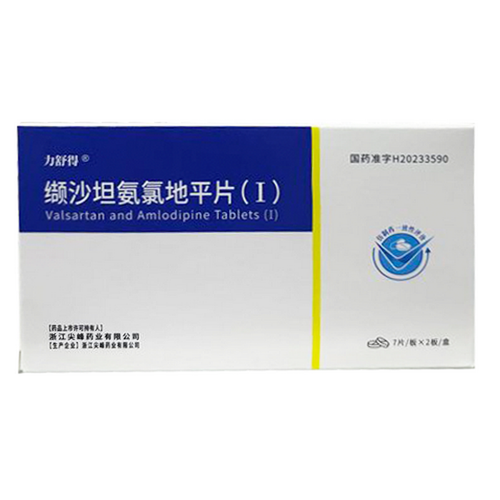Product Overview
[Drug Name]
Generic Name: Valsartan Amlodipine Tablets (I)
Trade Name: Besunan Valsartan Amlodipine Tablets (I) 28 Tablets
[Main Ingredients]
This product is a compound preparation containing 80 mg of valsartan and 5 mg of amlodipine per tablet.
[Properties]
Valsartan Amlodipine Tablets (I) are film-coated tablets. When the film coating is removed, the tablets appear white.
[Indications/Main Functions]
Treatment of essential hypertension. This product is used for patients whose blood pressure cannot be adequately controlled with monotherapy.
[Specifications]
28 tablets
[Dosage and Administration]
Amlodipine 2.5-10 mg once daily is effective for the treatment of hypertension, while the effective dose of valsartan is 80-320 mg. In clinical trials of once-daily Valsartan Amlodipine Tablets, using 5-10 mg of amlodipine and 80-320 mg of valsartan, the antihypertensive effect increased with increasing dose. Adverse reactions to valsartan are generally dose-independent; those to amlodipine are both dose-dependent (primarily peripheral edema) and dose-independent, with the former being more common than the latter. Patients whose blood pressure cannot be adequately controlled with monotherapy can be switched to betadalafil. Add-on therapy: Patients whose blood pressure is not adequately controlled with amlodipine or valsartan monotherapy can be switched to combination therapy with betadalafil. Patients who experience dose-limiting adverse reactions with amlodipine or valsartan monotherapy can use betadalafil, combining a lower dose of the single agent with the other component to achieve blood pressure control. Alternative therapy: For ease of dosing, patients receiving amlodipine and valsartan combination therapy can be switched to the same dose of betadalafil. For information on discontinuing beta-blockers, see Precautions. Both amlodipine and valsartan can be taken with or without food. Betadalafil is recommended for administration with water. Hepatic and renal impairment: No dose adjustment is required for patients with mild to moderate renal impairment. Use with caution in patients with severe renal impairment (see Contraindications). Patients with liver impairment or biliary obstructive disease should also use this product with caution.
[Adverse Reactions]
The safety of this product has been evaluated in five controlled clinical trials involving a total of 5,175 patients, of which 2,613 received valsartan and amlodipine in combination. The safety of valsartan and amlodipine tablets has been evaluated in over 2,600 hypertensive patients; over 1,440 patients received treatment for more than six months, and over 540 patients received treatment for more than one year. Adverse reactions are generally mild and transient, rarely requiring discontinuation. The overall incidence of adverse reactions is dose-independent and unrelated to gender, age, and race. In placebo-controlled clinical studies, 1.8% of patients treated with valsartan and amlodipine tablets discontinued treatment due to side effects, compared with 2.1% of patients in the placebo group. The most common reasons for discontinuation were peripheral edema (0.4%) and dizziness (0.2%). In placebo-controlled clinical trials, adverse reactions occurring in at least 2% of patients receiving this product and occurring more frequently in the valsartan-amlodipine tablets group (n=1437) than in the placebo group (n=337) included: peripheral edema (5.4% vs. 3.0%), nasopharyngitis (4.3% vs. 1.8%), upper respiratory tract infection (2.9% vs. 2.1%), and dizziness (2.1% vs. 0.9%). Orthostatic events (orthostatic hypotension and postural dizziness) occurred in less than 1% of patients. Other adverse reactions (20.2%) occurring in the valsartan-amlodipine tablets group in placebo-controlled clinical trials are listed below. It is uncertain whether these adverse reactions are attributable to this product.
[Contraindications]
Valsartan-amlodipine tablets (I) are contraindicated in patients with a hypersensitivity to the active ingredient or any of the excipients of this product. This product is contraindicated in pregnant and lactating women (see [Use in Pregnant and Lactating Women]). There are currently no data on its use in patients with severe renal impairment (creatinine clearance <10 mI/min). This product should be contraindicated in patients with hereditary angioedema and those who develop angioedema early in treatment with ACE inhibitors or angiotensin II receptor antagonists.
[Precautions]
1. Hypotension: In placebo-controlled trials, 0.4% of patients with uncomplicated hypertension treated with valsartan and amlodipine tablets experienced excessive hypotension. Patients with an activated renin-angiotensin system (e.g., those with volume and/or salt depletion taking high-dose diuretics) may experience symptomatic hypotension when receiving angiotensin II receptor antagonists. It is recommended to correct any volume depletion before initiating valsartan and amlodipine tablets (I) or to conduct close clinical monitoring when initiating treatment. Caution should be exercised when initiating treatment in patients with heart failure or a recent myocardial infarction, and in patients undergoing surgery or dialysis. Valsartan administration to patients with heart failure or post-myocardial infarction often causes a decrease in blood pressure. However, if dosing instructions are adhered to, discontinuation of treatment due to persistent symptomatic hypotension is generally unnecessary. In controlled clinical trials in patients with heart failure, the incidence of hypotension was 5.5% in patients receiving valsartan and 1.8% in the placebo group. In the Valsartan Acute Myocardial Infarction Trial (VALIANT), the incidence of permanent discontinuation of treatment due to hypotension in post-myocardial infarction patients was 1.4% in the valsartan group and 0.8% in the captopril group. 2. Increased Risk of Myocardial Infarction or Angina: Rarely, patients (particularly those with severe obstructive coronary artery disease) may experience an increase in the frequency, duration, or severity of angina or acute myocardial infarction when initiating or increasing the dose of calcium channel blockers. The mechanism of this effect is unknown. 3. Hepatic Impairment. 4. Amlodipine Studies: Amlodipine is extensively metabolized by the liver. In patients with hepatic impairment, the plasma elimination half-life (t½) is 56 hours. Therefore, amlodipine should be used with caution in patients with severe hepatic impairment. 5. Valsartan Studies: Valsartan is primarily eliminated via bile. In patients with mild to moderate chronic liver disease, including those with biliary obstruction, valsartan exposure (measured by AUC) averaged twice that of healthy volunteers (matched for age, sex, and weight). This drug should be used with caution in patients with liver disease or biliary obstruction.







